RELIGIÓN Y RELIGIONES3: ORDEN DEL PHOENIX. The phoenix (Ancient Greek: Φοῖνιξ, phoínix, Persian: ققنوس, Arabic: العنقاء) is a mythical sacred firebird that can be found in the mythologies of the Persians, Greeks, Romans, Egyptians, Chinese, and (according to Sanchuniathon) Phoenicians.
Phoenix (mythology)
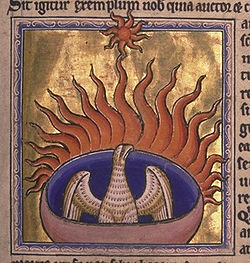
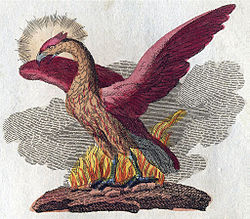
The phoenix (Ancient Greek: Φοῖνιξ, phoínix, Persian: ققنوس, Arabic: العنقاء) is a mythical sacred firebird that can be found in the mythologies of the Persians, Greeks, Romans, Egyptians, Chinese, and (according to Sanchuniathon) Phoenicians.
A phoenix is a mythical bird that is a fire spirit with a colorful plumage and a tail of gold and scarlet (or purple, blue, and green according to some legends). It has a 500 to 1000 year life-cycle, near the end of which it builds itself a nest of twigs that then ignites; both nest and bird burn fiercely and are reduced to ashes, from which a new, young phoenix or phoenix egg arises, reborn anew to live again. The new phoenix is destined to live as long as its old self. In some stories, the new phoenix embalms the ashes of its old self in an egg made of myrrh and deposits it in the Egyptian city of Heliopolis (literally "sun-city" in Greek). It is said that the bird's cry is that of a beautiful song. The Phoenix's ability to be reborn from its own ashes implies that it is immortal, though in some stories the new Phoenix is merely the offspring of the older one. In very few stories they are able to change into people.
The Roman poet Ovid wrote the following about the phoenix:
Most beings spring from other individuals; but there is a certain kind which reproduces itself. The Assyrians call it the Phoenix. It does not live on fruit or flowers, but on frankincense and odoriferous gums. When it has lived five hundred years, it builds itself a nest in the branches of an oak, or on the top of a palm tree. In this it collects cinnamon, and spikenard, and myrrh, and of these materials builds a pile on which it deposits itself, and dying, breathes out its last breath amidst odors. From the body of the parent bird, a young Phoenix issues forth, destined to live as long a life as its predecessor. When this has grown up and gained sufficient strength, it lifts its nest from the tree (its own cradle and its parent's sepulchre), and carries it to the city of Heliopolis in Egypt, and deposits it in the temple of the Sun.[1]
French author Voltaire thus described the phoenix:
It was of the size of an eagle, but its eyes were as mild and tender as those of the eagle are fierce and threatening. Its beak was the color of a rose, and seemed to resemble, in some measure, the beautiful mouth of Formosante. Its neck resembled all the colors of the rainbow, but more brilliant and lively. A thousand shades of gold glistened on its plumage. Its feet seemed a mixture of purple and silver; and the tail of those beautiful birds which were afterwards fixed to the car of Juno, did not come near the beauty of its tail.[2]
Contents[hide] |
[edit] History
The phoenix originated in ancient mythology and has gone through a variety of representations in art/literature, ranging from being fully birdlike to having the head of a dog and suckling its young. Typically, it is considered benevolent, but some tales suggest that humans are not always safe around it. Further, many tales share elements with those of the phoenix.
Flavius Philostratus (c. AD 170), who wrote the biography Life of Apollonius of Tyana, refers to the phoenix as a bird living in India, but sometimes migrating to Egypt every five hundred years. His account is clearly inspired by Garuda, the bird of the Hindu god Vishnu. He considered the bird as an emanation of sunlight, being in appearance and size much like an eagle. His contemporary Lactantius is probably the author who wrote the longest poem on the famous bird. Although descriptions (and life-span) vary, the Egyptian phoenix (Bennu bird) became popular in early Catholic art, literature and Catholic symbolism, as a symbol of Christ representing his resurrection, immortality, and life-after-death. One of the Early Catholic Church Fathers, Clement, related the following regarding the Phoenix in chapter 25 of the First Epistle of Clement:
Let us consider that wonderful sign [of the resurrection] which takes place in Eastern lands, that is, in Arabia and the countries round about. There is a certain bird which is called a phoenix. This is the only one of its kind, and lives five hundred years. And when the time of its dissolution draws near that it must die, it builds itself a nest of frankincense, and myrrh, and other spices, into which, when the time is fulfilled, it enters and dies. But as the flesh decays a certain kind of worm is produced, which, being nourished by the juices of the dead bird, brings forth feathers. Then, when it has acquired strength, it takes up that nest in which are the bones of its parent, and bearing these it passes from the land of Arabia into Egypt, to the city called Heliopolis. And, in open day, flying in the sight of all men, it places them on the altar of the sun, and having done this, hastens back to its former abode. The priests then inspect the registers of the dates, and find that it has returned exactly as the five hundredth year was completed.
Michael W. Holmes points out that early Christian writers justified their use of this myth because the word appears in Psalm 92:12 (LXX Psalm 91:13), but in that passage it actually refers to a palm tree, not a mythological bird.[3] However, it was the flourishing of Christian Hebraist interpretations of Job 29:18 that brought the Joban phoenix to life for Christian readers of the seventeenth century. At the heart of these interpretations is the proliferation of richly complementary meanings that turn upon three translations of the word chol (חול) — as phoenix, palm tree, or sand — in Job 29:18.[4]
In critical editions of English translations of I Clement, it is also noted that the story of the phoenix, with variations, is also found in Herodotus (ii. 73), Pliny (Nat. Hist. x.2), and used as above by Tertullian (De Resurrectione Carnis, §13) and other Church Fathers.[5][6]
Originally, the phoenix was identified by the Egyptians as a stork or heron-like bird called a benu, known from the Book of the Dead and other Egyptian texts as one of the sacred symbols of worship at Heliopolis, closely associated with the rising sun and the Egyptian sun-god Ra.
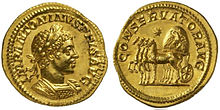
The Greeks subsequently pictured the bird more like a peacock or an eagle and identified it with their own word phoenix (Φοίνιξ), meaning the color purple-red or crimson (cf. Phoenicia) or a palm tree. According to the Greek mythology the phoenix lived in Phoenicia next to a well. At dawn, it bathed in the water of the well, and the Greek sun-god Helios stopped his chariot (the sun) in order to listen to its song. Featured in the painting Heracles Strangles Snakes (House of the Vettii, Pompeii Italy) as Zeus, the king of the gods. Herodotus spoke about the unique capabity of the bird to be consumed in the flames and be reborn from the ashes.
According to many, the flamingo of East Africa might have contributed to the myth of phoenix.[7][8] This bright pink or white bird nests on salt flats that are too hot for its eggs or chicks to survive; it builds a mound several inches tall and large enough to support its egg, which it lays in that marginally cooler location. The convection currents around these mounds resembles the turbulence of a flame. In zoology, flamingos are part of the family Phoenicopteridae, from the generic name Phoenicopterus or "phoenix-winged."
[edit] Related usage
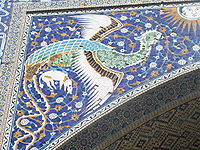
Simurgh (Persian: سیمرغ), also spelled simorgh, simurg, simoorg or simourv, also known as Angha (Arabic: العنقاء), is the modern Persian name for a fabulous, benevolent, mythical flying creature. The figure can be found in all periods of Greater Iranian art and literature, and is evident also in the iconography of medieval Armenia[9], the Byzantine empire [10], and other regions that were within the sphere of Persian cultural influence.
The name simurgh derives from Middle Persian Pahlavi sēnmurw[11][12] (and earlier sēnmuruγ), also attested in Middle Persian Pāzand as sīna-mrū. The Middle Persian term derives in turn from Avestan mərəγō Saēnō "the bird Saēna", originally a raptor, likely an eagle, falcon or sparrowhawk, as can be deduced from the etymological cognate Sanskrit śyenaḥ "raptor, eagle, bird of prey" that also appears as a divine figure. Saēna is also a personal name which is root of the name. Please note Simurgh and Phoenix are two separate mythical birds, and should not mixed up with one another.
In Persian mythology, Simurgh, (Persian: سيمرغ, Middle Persian: senmurv) was a winged, bird-like creature that was very large and extremely ancient with a long tail. The Simurgh appears in many Iranian literary classics such as Farid ud-Din Attar's Conference of the Birds as instructor and birds leader, and in Ferdowsi's epic Shahnameh (The Book of Kings); Simurgh raised up and cherished Zaal or Zal, father of Rostam.
Lebanon, and Beirut particularly, is often depicted symbolically as a phoenix bird having been destroyed and rebuilt 7 times during its long history.
In China, the Fenghuang (鳳凰) is a mythical bird superficially similar to the phoenix. It is the second most-respected legendary creature (second to the dragon), largely used to represent the empress and females, and as such as the counterpart to the Chinese dragon, traditionally seen as masculine or imperial. The phoenix is considered the greatest and the leader of birds.
In Japan, the phoenix is called hō-ō (kanji: 鳳凰) or fushichō (不死鳥), literally "Immortal Bird".
In Russian folklore, the phoenix appears as the Zhar-Ptitsa (Жар-Птица), or firebird, subject of the famous 1910 ballet score by Igor Stravinsky. The phoenix was featured in the flags of Alexander Ypsilantis and of many other captains during the Greek Revolution, symbolizing Greece's rebirth, and was chosen by John Capodistria (1828–1832). In addition, the first modern Greek currency bore the name of phoenix. Despite being replaced by a royal Coat of Arms, it remained a popular symbol, and was used again in the 1930s by the Second Hellenic Republic. However, its use by the military junta of 1967-1974 made it extremely unpopular, and it has almost disappeared from use after 1974, with the notable exception of the Greek Order of the Phoenix.
The constellation Phoenix, was introduced in the late 16th century by sailors organized by Petrus Plancius, probably one of Keyser or de Houtman and displayed on a globe from 1597 created by Hondius.
In ancient Arabic tradition the Ghoghnus or Ghoghnous is a bird having some mythical relation with the date palm. The Ghoghnus is said to have laid only one egg. It lived in the Arabian Desert many thousands of years ago.[13]
Zumrud-u Anka (Zümrüdüanka), Tuğrul or Devekuşu, is a Turkish version of the phoenix. The word Anka comes from the word for "necklace", for the bird's neck is covered with white feathers forming like a necklace.
[edit] Symbolism
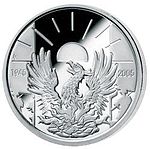
The Phoenix has long been presented as a symbol of rebirth, immortality, and renewal. The Belgian € 10 silver coin, commemorating sixty years of peace, depicts the Phoenix as a representation of a new Europe, post 1945.
[edit] Specific legends
- Fenghuang, commonly referred to as the Chinese phoenix.
- Firebird (Russian folklore), an equivalent of phoenix in Russian mythology.
- Bennu, an Egyptian correspondence to the phoenix.
- Angha, a Huma, Simurgh, Persian phoenixes.
- Adarna, a Philippine version of the phoenix.
- Avalerion, an Indian magic bird that drowns itself once it has laid its eggs.
- Turul, a mythical bird of the Magyars.
- Garuda, mythical bird of ancient India.
- Kokko, a mythical bird of iron and fire from Finnish folklore.
- Roc (mythology), an enormous legendary bird of prey, often white, reputed to have been able to carry off and eat elephants.
[edit] References in popular culture
[edit] See also
[edit] References
- ^ Thomas Bulfinch, Age of Fable: Vols. I & II: Stories of Gods and Heroes. 1913
- ^ The Princess of Babylon, in The Works of M. de Voltaire, vol XXXVI (vol. XXVI of the prose works), London, MDCCLXIX, pp. 14-15.
- ^ (Holmes, The Apostolic Fathers: Greek texts and English translations, page 59.)
- ^ EMLS 11.2 (September, 2005): 5.1-15] Milton's Joban Phoenix in Samson Agonistes
- ^ Schaff, Philip. Ante-Nicene Fathers, vol. I., CLEMENT OF ROME, First Epistle to the Corinthians, Chapter XXV.
- ^ Lake, Kirsopp. The Apostolic Fathers, vol. I. Cambridge, MA: Harvard University Press, 1912, p. 53
- ^ "Phoenicopteriformes". http://www.novelguide.com/a/discover/grze_08/grze_08_00531.html. Retrieved 2010-11-15.
- ^ "5 Things about Flamingos". http://news.softpedia.com/news/5-Things-About-Flamingos-85240.shtml. Retrieved 2010-11-15.
- ^ For example, fresco depiction of simurghs inside medallions (evoking motifs found on Sassanid textiles) in the church of Tigran Honents at Ani. P Donabedian and J. M. Thierry, Armenian Art, New York, 1989, p. 488.
- ^ For example, a row of simurghs are depicted inside the "Ağaçaltı" church in the Ihlara gorge. Thierry, N. and M., Nouvelles églises rupestres de Cappadoce, Paris, 1963, p. 84-85.
- ^ A. Jeroussalimskaja, "Soieries sassanides", Splendeur des sassanides: l'empire perse entre Rome et la Chine (Brussels, 1993) pp. 114, 117f, points out that the spelling senmurv, is incorrect (noted by David Jacoby, "Silk Economics and Cross-Cultural Artistic Interaction: Byzantium, the Muslim World, and the Christian West", Dumbarton Oaks Papers 58 (2004:197-240) p. 212 note 82.
- ^ Hanns-Peter Schmidt,"Simorgh" in Encyclopedia Iranica
- ^ Quranic articles; Vegetables in Holy Quran – The date-palm
- Umberto Capotummino" L'Occhio della Fenice", Palermo, Sekhem, 2005. ISBN 88-902054-0-7
- R. Van den Broek, The Myth of the Phoenix - According to Classical and Early Christian Traditions, E.J.Brill, Leiden, 1972.
- Silvia Fabrizio-Costa (ed.), La Fenice : mito e segno (simposio dell’università di Caen), Peter Lang, Bern, 2001. ISBN 3-906767-89-2
- Françoise Lecocq, « Les sources égyptiennes du mythe du phénix », L’Egypte à Rome (simposio dell’università di Caen), éd. F. Lecocq, Cahiers de la Maison de la Recherche en Sciences Humaines, n° 41, Caen, 2005. ISSN 1250-6419, reed. 2008 (p. 211-266).
- Francesco Zambon, Alessandro Grossato, Il mito della fenice in Oriente e in Occidente, Venezia, Marsilio Editori, 2004. ISBN 88-317-8614-8
- Françoise Lecocq, « L’iconographie du phénix à Rome », Images de l’animal dans l’Antiquité. Des figures de l’animal au bestiaire figuré, to be published at Presses universitaires de Caen; preprint on line: Université de Caen Basse-Normandie, p. 73-106. (French)
- Françoise Lecocq, « L’œuf du phénix. Myrrhe, encens et cannelle dans le mythe du phénix », L’animal et le savoir, de l’Antiquité à la Renaissance, to be published at Presses univ. de Caen ; preprint on line : Université de Caen Basse-Normandie, p. 107-130. (French)
[edit] External links
| Wikiquote has a collection of quotations related to: Phoenix |
| Wikimedia Commons has media related to: Phoenix |
- Entry for the Phoenix in The Aberdeen Bestiary
- Dave's Mythical Creatures and Places: Phoenix
- Mythological Creatures - The Phoenix at Helium.com [1]
- Giant Phoenix puppet from 2001 NY Village Halloween Parade
- The Medieval Bestiary: Phoenix
- Phoenix from India
- Account of the Grecian author, Flavius Philostratus
- Phoenix in China
| |||||||||||||||||||
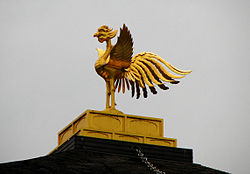
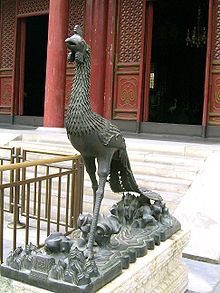

0 comentarios